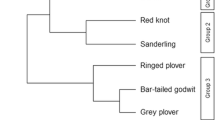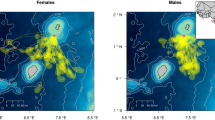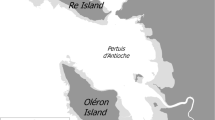Synopsis
Nocturnal foraging habitats of Haemulon flavolineatum and H. sciurus were investigated in the backreef habitat around Tobacco Caye, Belize. Grunts leave the reef at dusk to forage in the grass beds and sand flats surrounding the reef. The hypothesis that French and bluestriped grunts use separate foraging habitats was examined by following tagged fishes from their diurnal territories or schooling sites to nocturnal foraging grounds. The tag consisted of a small, glowing Cyalume light stick sutured to the dorsal musculature of the fish, next to the first dorsal fin. Surveys of foraging habitats were done to support the tracking study. Large quadrats (225 m2) were set out over the sand flats and grass beds during the day. The numbers of French and bluestriped grunts feeding in each habitat were counted one hour after dark. Foraging French grunts used sand flats, whereas bluestriped grunts usually fed in grass beds. Repeated sightings of two French grunts and one bluestriped grunt in the same individual night-time locations support the hypothesis that nocturnal foraging sites may be used repeatedly by the same individuals.
Similar content being viewed by others
References cited
Burke, N.C. & H.E. Winn.1994. Cyalume tagging: a new method for tracking reef fishes at night. J. Fish Biol. (in press).
Courtenay, W.R. Jr. 1961. Western Atlantic fishes of the genus Haemulon (Pomadasyidae): systematic status and juvenile pigmentation. Bull. Mar. Sci. Gulf Caribb. 11: 66–149.
Dodson, J.J. 1988. The nature and role of learning in the orientation and migratory behavior of fishes. Env. Biol. Fish. 23: 161–182.
Ebeling, A.W. & M.A. Hixon. 1991. Tropical and temperate reef fishes: comparison of community structures. pp. 509–563. In: P.F. Sale (ed.) The Ecology of Fishes on Coral Reefs, Academic Press, San Diego.
Ehrlich, P.R. & A.H. Ehrlich. 1973. Coevolution: heterotypic schooling in Caribbean reef fishes. Amer. Nat. 107: 157–160.
Gladfelter, W.B. & W.S. Johnson. 1983. Feeding niche separation in a guild of tropical reef fishes Holocentridae). Ecology 64: 552–563.
Helfman, G.S. 1993. Fish behaviour by day, night and twilight. pp. 479–511. In: T.J. Pitcher (ed.) Behaviour of Teleost Fishes, Chapman & Hall, London.
Helfman, G.S., J.L. Meyer & W.N. McFarland. 1982. The ontogeny of twilight migration patterns in grunts (Pisces: Haemulidae). Anim. Behav. 30: 317–326.
Helfman, G.S. & E.T. Schultz. 1984. Social transmission of behavioural traditions in a coral reef fish. Anim. Behav. 32: 379–384.
Hobson, E.S. 1968. Predatory behavior of some shore fishes in the Gulf of California. U.S. Fish Wildl. Serv., Res. Rep. 73: 1–92.
Hobson, E.S. 1972. Activity of Hawaiian reef fishes during the evening and morning transitions between daylight and darkness. U.S. Fish. Bull. 70: 715–740.
Hobson, E.S. 1973. Diel feeding migrations in tropical reef fishes. Helgolander wiss. Meeresunters. 24: 361–370.
Hobson, E.S. 1979. Interactions between piscivorous fishes and their prey. pp. 231–242. In: H. Clepper (ed.) Predator-Prey Systems in Fisheries Management, Sport Fishing Institute, Washington, D.C.
Hobson, E.S., W.N. McFarland & J.R. Chess. 1981. Crepuscular and nocturnal activities of Californian nearshore fishes, with consideration of their scotopic visual pigments and the photic environment. U.S. Fish. Bull. 79: 1–30.
Kamil, A.S. & H.L. Roitblat. 1985. The ecology of foraging behavior: implications for animal learning and memory. Ann. Rev. Psychol. 36: 141–169.
Major, P.F. 1977. Predator-prey interactions in schooling fishes during periods of twilight: a study of the silverside Pranesus insularum in Hawaii. U.S. Fish. Bull. 75: 415–426.
McFarland, W.N. & Z.M. Hillis. 1982. Observations on agonistic behavior between members of juvenile French and white grunts — family Haemulidae. Bull. Mar. Sci. 32: 255–268.
McFarland, W.N., J.C. Ogden & J.N. Lythgoe. 1979. The influence of light on the twilight migrations of grunts. Env. Biol. Fish. 4: 9–22.
Motcheck, A.D. & A.F. Silva Lee. 1975. Conducta social del genero Haemulon. Academia Ciencias de Cuba Instituto de Oceanologia, Serie Oceanologica 27: 1–10.
Ogden, J.C. & P.R. Ehrlich. 1977. The behavior of heterotypic resting schools of juvenile grunts (Pomadasyidae). Marine Biology 42: 273–280.
Ogden, J.C. & T.P. Quinn. 1984. Migration in coral reef fishes: ecological significance and orientation mechanisms. pp. 293–308. In: J.D. McCleave, G.P. Arnold, J.J. Dodson & W.H. Neill (ed.) Mechanisms of Migration in Fishes, Plenum Press, New York.
Ogden, J.C. & J.C. Zieman. 1977. Ecological aspects of coral reef-seagrass bed contacts in the Caribbean. Proceedings of the Third International Coral Reef Symposium, Miami: 1: 377–382.
Quinn, T.P. & J.C. Ogden. 1984. Field evidence of compass orientation in migrating juvenile grunts (Haemulidae). J. Exp. Mar. Biol. Ecol. 81: 181–192.
Reese, E.S. 1989. Orientation behavior of butterflyfishes (family Chaetodontidae) on coral reefs: spatial learning of route specific landmarks and cognitive maps. Env. Biol. Fish. 25: 79–86.
Robblee, M.B. & J.C. Zieman. 1984. Diel variation in the fish fauna of a tropical seagrass feeding ground. Bull. Mar. Sci. 34: 335–345.
Ross, S.T. 1986. Resource partitioning in fish assemblages: a review view of field studies. Copeia 1986: 352–388.
Starck, W.A. II & W.P. Davis. 1966. Night habits of fishes of Alligator Reef, Florida. Ichthyologica, Aquar. J. 38: 313–356.
Thorpe, W.H. 1963. Learning and instinct in animals. Methuen, London. 558 pp.
Tulevech, S.M. 1991. Migratory habits of white grunt, Haemulon plumieri, as determined by acoustic telemetry in Puerto Rico and Florida. M.S. Thesis, University of Rhode Island, Kingston. 77 pp.
Author information
Authors and Affiliations
Rights and permissions
About this article
Cite this article
Burke, N.C. Nocturnal foraging habitats of French and bluestriped grunts, Haemulon flavolineatum and H. sciurus, at Tobacco Caye, Belize. Environ Biol Fish 42, 365–374 (1995). https://doi.org/10.1007/BF00001467
Received:
Accepted:
Issue Date:
DOI: https://doi.org/10.1007/BF00001467




